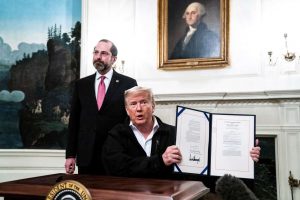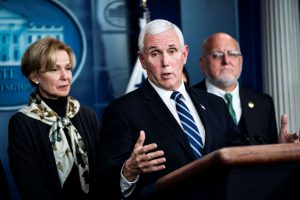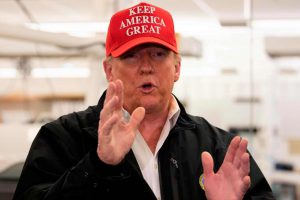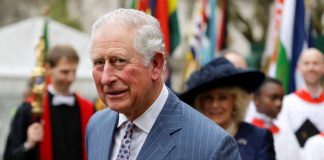MARCH 7, 2020

President Trump, with Health and Human Services Secretary Alex Azar by his side, signs an $8.3 billion emergency spending bill to combat the coronavirus outbreak at the White House Friday. – Jabin Botsford/WashPost
The coronavirus had already begun to spiral out of control around the world when Health and Human Services Secretary Alex Azar, during routine Senate testimony, made a surprising claim.
“As of today, I can announce that the CDC has begun working with health departments in five cities to use its flu surveillance network to begin testing individuals with flu-like symptoms for the Chinese coronavirus,” Azar said. “This effort will help see whether there is broader spread than we have been able to detect so far.”
But there were two major problems: The cities weren’t ready, and the tests didn’t work.
In fact, when Azar’s team had sent his prepared remarks to the Centers for Disease Control and Prevention before delivery, the agency pushed back and urged him to soften his language. State health departments had not yet been informed of the plans — and were certain to be upset by them — and the coronavirus test kits contained a faulty component that caused a spike in inconclusive results. Azar announced the plans anyway, in part because “it would be really valuable for him [to] have the news,” as one HHS official put it in an internal email.
Two senior officials said they wanted Azar to share the information because they expected the CDC to make its announcement shortly.
Azar’s bungled announcement before the Senate Finance Committee on Feb. 13 was just one of many preventable missteps and blunders in the federal government’s handling of the coronavirus crisis — the embodiment of an administration that, for weeks, repeatedly squandered opportunities to manage and prepare for a global epidemic that has killed thousands worldwide and at least 19 so far in the United States.
This portrait of the precious weeks that President Trump and his administration frittered away in trying to deal with the coronavirus is the result of interviews with 16 current and former administration officials, state health officials and outside experts, many of whom spoke on the condition of anonymity to share candid assessments.
Public health experts and officials faced a deluge of challenges, almost from the beginning. First there were the problems with the initial coronavirus test kits, which contained an unspecified problem with a compound that prompted inconclusive results; it took experts nearly three weeks of troubleshooting to find a workaround. Initial U.S. guidelines for testing also were overly narrow, only screening individuals who presented with respiratory symptoms and had either recently traveled to China or come in close contact with an infected person.
Infighting quickly materialized among agencies that have long had poor relationships — feuding was especially intense between the CDC and the Office of the Assistant Secretary for Preparedness and Response — and when the situation went awry, recriminations were swift. Public health officials and experts also struggled to find an uneasy equilibrium between doing their jobs honestly and transparently while trying to manage a mercurial president, who griped about what he viewed as overheated rhetoric by officials and the media.
At the White House, Trump and many of his aides were initially skeptical of just how serious the coronavirus threat was, while the president often seemed uninterested as long as the virus was abroad. At first, when he began to engage, he downplayed the threat — “The Coronavirus is very much under control in the USA,” he tweeted in late February — and became a font of misinformation and confusion, further muddling his administration’s response.
On Friday, visiting the CDC in Atlanta, the president spewed more falsehoods when he claimed, incorrectly: “Anybody that needs a test, gets a test. They’re there. They have the tests. And the tests are beautiful.”
Public health and infectious-disease experts have lamented that the faulty CDC test and limited testing criteria delayed officials’ abilities to detect the virus’s spread throughout the United States. They also said the government expended too much time and too many resources on trying to contain a virus — at 70 times smaller than a single blood cell — that scientists and doctors quickly realized spread easily and stealthily.
The virus was hopscotching around the world in the middle of cold and flu season and presenting with similar symptoms — including a cough and fever — that made it difficult to distinguish from other common ailments without a diagnostic test.
Several experts said the United States should have spent more time making sure hospitals and state and local health departments had the money, training, personal protective equipment and resources they needed to respond to outbreaks. But the White House’s messaging in January and well into late February that the virus was contained and under control probably led health-care facilities to be insufficiently prepared, these experts added.
“They should have been telling every hospital to be prepared to see these cases, knowing how to manage bed space in hospitals if this gets bad and preparing the public for the fact that we’re going to be facing a pandemic rather than saying it’s containable,” said Amesh Adalja, a senior scholar at the Johns Hopkins University Center for Health Security and an infectious-disease physician. “The idea of containment requires a lot of public health resources that can be better spent.”
President Trump, with Health and Human Services Secretary Alex Azar by his side, signs an $8.3 billion emergency spending bill to combat the coronavirus outbreak at the White House Friday. – Jabin Botsford/WashPost
‘Significant disruption’
During a late January meeting at the White House, Azar was having trouble focusing Trump’s full attention on his coronavirus briefing. Azar had arrived to brief the president on the latest virus news, but Trump instead interjected, badgering the health chief about the administration’s messy decision to implement a limited ban on flavored e-cigarettes.
Why did you push me to insert myself into a controversial political issue? Trump demanded.
Even as the president remained distracted, signs of the impending virus crisis loomed.
By then, it was already clear that the virus had been spreading in China since early December. Wuhan and several other Chinese cities essentially shut down around Jan. 23, an early sign of just how serious the threat was.
Shortly after that meeting between Azar and Trump, the White House declared a “public health emergency,” announcing quarantines and major travel restrictions — including barring most non-U.S. citizens who recently visited China from entering the United States — intended to limit contagion.
Some experts argued this was the wrong approach because people with the disease had probably been flying all over the world for weeks by then, especially since the virus was hard to detect. Others said the measures would buy the administration time it could use to prepare for the coming onslaught.
Around this time, in the early days of February, the CDC got its diagnostic test up and running. But the testing criteria was extremely narrow: Only those with recent travel to China or those who had come into contact with a confirmed infection would be tested.

A cruise ship worker cleans a railing on the Grand Princess on Thursday off the California coast, where the ship is being held amid a coronavirus outbreak. – Michele Smith/AP
Then came the testing errors, as some labs began reporting inconclusive results from the CDC kits. The problem with tests quickly snowballed, becoming a self-perpetuating cycle. Because the tests were faulty and the testing criteria so limited, the government was missing a lot of the cases because it couldn’t scale up. Some in the administration didn’t initially take the crisis more seriously, in part, because it appeared that the case count was low.
Internally, some officials — including Joe Grogan, director of the Domestic Policy Council, and Ken Cuccinelli, acting deputy secretary of homeland security — were raising questions about the testing process, asking if officials were sure they were catching all the cases. Grogan was also frustrated with HHS for the department’s initial inability to coordinate a national testing strategy.
The urgency was already too late. It was not until the week of Valentine’s Day that Azar and, later, the CDC announced the plans to use five influenza surveillance labs around the country to also test for coronavirus. The five cities were supposed to be Atlanta, Chicago, New York, Los Angeles and San Francisco, but the tests were still plagued by problems and they couldn’t get the effort up and running. Chicago did not begin testing until this past week.
Until the end of February, only about a dozen labs outside of the CDC had the ability to do their own testing for the virus.
Health officials were sounding increasingly dire public warnings. At a regularly scheduled media briefing for reporters on Feb. 25, Nancy Messonnier, director of the CDC’s National Center for Immunization and Respiratory Diseases, focused her remarks on community mitigation — such as closing schools or avoiding mass gatherings — rather than the detective work of tracking down and trying to contain existing cases.
Messonnier told reporters that she had sat her children down and, over breakfast, told them that while they weren’t yet at risk, “as a family, we need to be preparing for significant disruption in our lives.”
CDC officials had informed HHS officials in advance of the theme of Messonnier’s comments, and no one from HHS gave any indication immediately afterward that there was any problem. “Nobody thought the messages were wrong,” the official said.
But Trump, watching from abroad in India, was furious at what he viewed as her alarmist rhetoric, which he feared would further tank the already gyrating markets. Word trickled back that Messonnier’s blunt talk was “just too early.”
‘Bad things happen’
Last weekend, on Feb. 29, the Food and Drug Administration finally announced its more lenient testing guidelines — allowing academic and hospital labs to create and perform their own diagnostic coronavirus tests.
But the news could have come far sooner, officials said. Behind the scenes, some FDA officials — having realized the CDC tests were faulty — began pushing for a loosening of testing standards earlier in February, according to three high-level officials. Two other senior officials, however, denied this and said the FDA was solely focused on the CDC test.
Several officials also asserted that key players were missing in the early days of the response — most notably from the FDA, which can work with private manufacturers on diagnostics, therapeutics and vaccine development. FDA Commissioner Stephen Hahn participated in some media briefings and FDA officials took part in HHS briefings, but Hahn was not added to the task force until the end of February, after Vice President Pence took over the response.
Two senior administration officials argued that, even in hindsight, the administration might not have done much differently, in part because it was important for the CDC to figure out exactly why its tests weren’t working. Another quality-control issue, for instance, could have yielded more inconclusive results, further exacerbating the problem, these officials added.
Some in the administration, including Trump himself, viewed the initial steps to contain the virus as the solution — rather than merely as a starting point from which to use to buy themselves more time.
“We have contained this,” Trump economic adviser Larry Kudlow told CNBC the last week of February. “I won’t say airtight, but it’s close to airtight.”
Many public health officials say the administration did not make good use of crucial time before the virus emerged in the United States.
“The draconian quarantines imposed by the Chinese bought us time, and have we used that time to good purpose, to prepare ourselves? And the short answer is no,” said Stephen Morrison, a senior vice president at the Center for Strategic and International Studies, where he directs the center’s global health work. “How many people have been tested in our country? How much has been done to make sure the hospitals and clinics are prepared for what may come, in terms of basic protective gear and the like?”
The repeated false claims by the president that the virus was being contained exacerbated the problem. They made it difficult for public health officials to lay out the need to prepare for what happens next, even after most experts had begun to fear the virus was already here and spreading. There was also a ripple effect, with health officials and others not taking the threat as seriously as they should have because Trump kept on making faulty assurances, such as his claim at a Feb. 26 news conference that within the United States, the number of cases was “going to be down to close to zero.”

Vice President Pence, with members of the coronavirus task force, speaks at the White House on Tuesday. – Jabin Botsford/WashPost
Confusion in the ranks below Trump made things worse.
The $8.3 billion in supplemental funds for emergency coronavirus aid, which Trump signed into law Friday, should have been requested a month earlier, many officials and experts said. Had the request come sooner, government agencies could have gotten an earlier start to research and develop vaccines; they could have ensured that state and local health departments had the money and resources they needed to support lab testing and infection control, transportation and lodging for people needing quarantine; and hospitals could have stockpiled supplies such as masks and gowns.
The FDA also should have been point on all things diagnostics, as the FDA can work with private manufacturers to help ramp up production more quickly. Though the CDC can produce these testing kits in small-scale situations, the agency was never equipped to be a large-scale diagnostics manufacturer.
There were other problems, including an inadequate supply of personal protective equipment — especially the lack of N95 respirators, those specialized face masks that are the most effective for protecting front-line health-care workers.
Robert Kadlec, the assistant secretary for preparedness and response, had taken over the Strategic National Stockpile — which is supposed to store this sort of equipment — in 2018. But when authorities in Washington state, the epicenter of the U.S. outbreak, urgently requested 233,000 respirators and 200,000 surgical masks, they initially received just half of what they had asked for.
“All of this led to an unbalanced response,” said one expert on preparedness, who spoke on the condition of anonymity to speak candidly. “If you can’t coordinate across agencies and raise flags when things are going very wrong, bad things happen.”
A ‘perfect’ test
The White House began Friday with an apparent lie: The president, the White House said in a statement, had canceled a planned trip to the CDC in Atlanta because he did “not want to interfere” with the mission of the agency, which had been working nonstop to combat the virus.
But the president soon contradicted his own press office, telling reporters that his trip had been canceled because of a suspected case of coronavirus on the CDC campus, which turned out to be negative.
“So I may be going,” said Trump, who did indeed continue on with his visit as planned.

“Anybody who wants a test will get a test, that’s the bottom line,” Trump said while touring the CDC. – Jim Watson/AFP/Getty Images
Once in Atlanta, the president’s misstatements continued. Just one day prior, Pence had offered a disconcerting admission as he traveled to the West Coast: “We don’t have enough tests today to meet what we anticipate will be the demand going forward.”
Yet there was Trump, touring the CDC in a red “Keep America Great” campaign hat and offering an alternative reality just 24 hours later during a chaotic appearance: “Anybody who wants a test will get a test, that’s the bottom line,” said Trump, who went on to describe the coronavirus testing kits as being nearly as “perfect” as his phone call with the Ukrainian president last summer, which ultimately led to his impeachment.
Then Trump ended the day by injecting yet another note of chaos into an already frenetic period, tweeting out news of a major staff shake-up.
“I am pleased to announce that Congressman Mark Meadows will become White House Chief of Staff,” he wrote, pivoting away from coronavirus, at least briefly.
Courtesy/Source: Washington Post










































































































